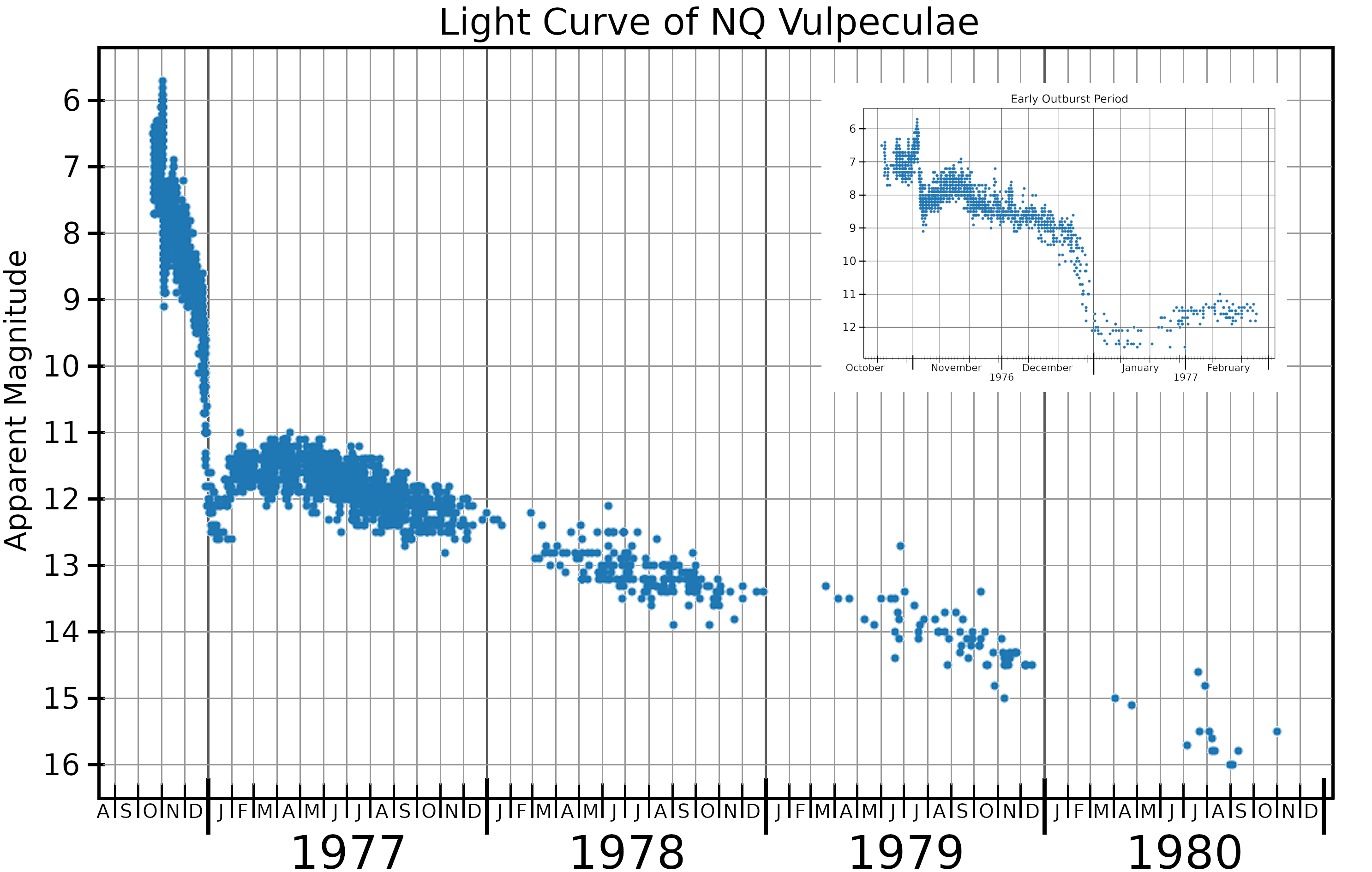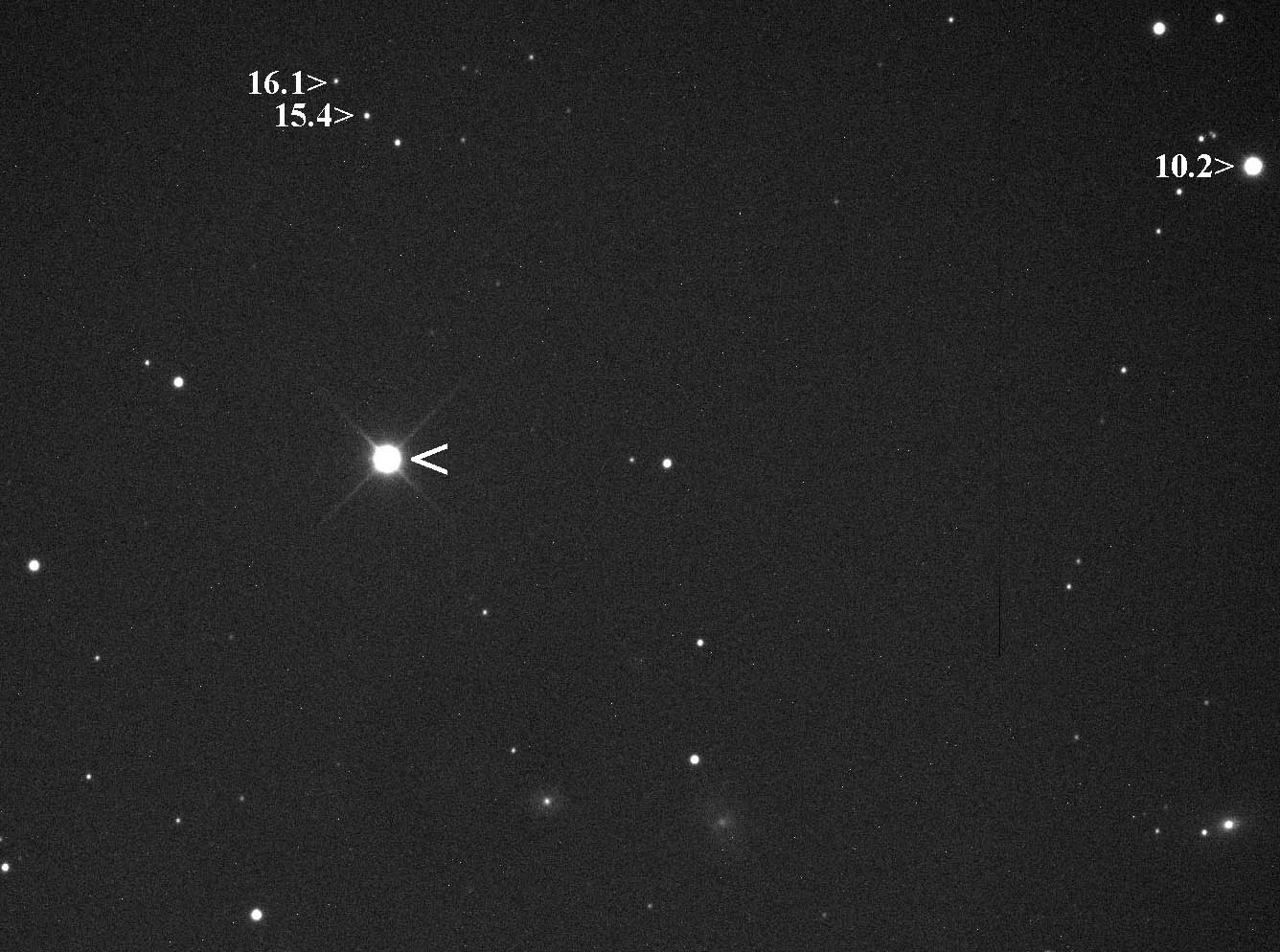|
NQ Vulpeculae
NQ Vulpeculae also known as Nova Vulpeculae 1976, was a nova that appeared in the constellation Vulpecula in 1976. It was discovered visually at 18:20 UT on October 21, 1976 by English amateur astronomer George Alcock. Its apparent magnitude at the time of discovery was 6.5 It reached its maximum brightness of magnitude 6.0 thirteen days after its discovery, at which point it may have been faintly visible to the naked eye. A few days after maximum brightness, it had faded to magnitude 8.3. NQ Vulpeculae faded by 3 magnitudes from peak brightness in 65 days, which makes it a "moderate speed" nova. It was one of the first novae to be closely monitored near peak brightness in the infrared. The visual light curve went through a local minimum in January 1977 (resulting in its classification as a DQ Herculis-type nova), and at the same time near infrared (3.5 micron) emission peaked, signalling the formation of a dust shell around the nova. The IRAS satellite was ... [...More Info...] [...Related Items...] OR: [Wikipedia] [Google] [Baidu] |
Vulpecula (constellation)
Vulpecula is a faint constellation in the northern sky. Its name is Latin for "little fox", although it is commonly known simply as the fox. It was identified in the seventeenth century, and is located in the middle of the Summer Triangle (an asterism consisting of the bright stars Deneb, Vega, and Altair). Features Stars There are no stars brighter than 4th magnitude in this constellation. The brightest star in Vulpecula is Alpha Vulpeculae, a magnitude 4.44m red giant at a distance of 297 light-years. The star is an optical binary (separation of 413.7") that can be split using binoculars. The star also carries the traditional name Anser, which refers to the goose the little fox holds in its jaws. 23 Vulpeculae is the second brightest star in the constellation. In 1967, the first pulsar, PSR B1919+21, was discovered in Vulpecula by Jocelyn Bell, supervised by Antony Hewish, in Cambridge. While they were searching for scintillation of radio signals of quasars, they observed ... [...More Info...] [...Related Items...] OR: [Wikipedia] [Google] [Baidu] |
White Dwarf
A white dwarf is a stellar core remnant composed mostly of electron-degenerate matter. A white dwarf is very dense: its mass is comparable to the Sun's, while its volume is comparable to the Earth's. A white dwarf's faint luminosity comes from the emission of residual thermal energy; no fusion takes place in a white dwarf. The nearest known white dwarf is at 8.6 light years, the smaller component of the Sirius binary star. There are currently thought to be eight white dwarfs among the hundred star systems nearest the Sun. The unusual faintness of white dwarfs was first recognized in 1910. The name ''white dwarf'' was coined by Willem Luyten in 1922. White dwarfs are thought to be the final evolutionary state of stars whose mass is not high enough to become a neutron star or black hole. This includes over 97% of the other stars in the Milky Way. After the hydrogen- fusing period of a main-sequence star of low or medium mass ends, such a star will expand to a red gi ... [...More Info...] [...Related Items...] OR: [Wikipedia] [Google] [Baidu] |
Novae
A nova (plural novae or novas) is a transient astronomical event that causes the sudden appearance of a bright, apparently "new" star (hence the name "nova", which is Latin for "new") that slowly fades over weeks or months. Causes of the dramatic appearance of a nova vary, depending on the circumstances of the two progenitor stars. All observed novae involve white dwarfs in close binary systems. The main sub-classes of novae are classical novae, recurrent novae (RNe), and dwarf novae. They are all considered to be cataclysmic variable stars. Classical nova eruptions are the most common type. They are likely created in a close binary star system consisting of a white dwarf and either a main sequence, subgiant, or red giant star. When the orbital period falls in the range of several days to one day, the white dwarf is close enough to its companion star to start drawing accreted matter onto the surface of the white dwarf, which creates a dense but shallow atmosphere. This atmosp ... [...More Info...] [...Related Items...] OR: [Wikipedia] [Google] [Baidu] |
Nature (journal)
''Nature'' is a British weekly scientific journal founded and based in London, England. As a multidisciplinary publication, ''Nature'' features peer-reviewed research from a variety of academic disciplines, mainly in science and technology. It has core editorial offices across the United States, continental Europe, and Asia under the international scientific publishing company Springer Nature. ''Nature'' was one of the world's most cited scientific journals by the Science Edition of the 2019 '' Journal Citation Reports'' (with an ascribed impact factor of 42.778), making it one of the world's most-read and most prestigious academic journals. , it claimed an online readership of about three million unique readers per month. Founded in autumn 1869, ''Nature'' was first circulated by Norman Lockyer and Alexander Macmillan as a public forum for scientific innovations. The mid-20th century facilitated an editorial expansion for the journal; ''Nature'' redoubled its efforts in ... [...More Info...] [...Related Items...] OR: [Wikipedia] [Google] [Baidu] |
International Astronomical Union
The International Astronomical Union (IAU; french: link=yes, Union astronomique internationale, UAI) is a nongovernmental organisation with the objective of advancing astronomy in all aspects, including promoting astronomical research, outreach, education, and development through global cooperation. It was founded in 1919 and is based in Paris, France. The IAU is composed of individual members, who include both professional astronomers and junior scientists, and national members, such as professional associations, national societies, or academic institutions. Individual members are organised into divisions, committees, and working groups centered on particular subdisciplines, subjects, or initiatives. As of 2018, the Union had over 13,700 individual members, spanning 90 countries, and 82 national members. Among the key activities of the IAU is serving as a forum for scientific conferences. It sponsors nine annual symposia and holds a triannual General Assembly that sets policy ... [...More Info...] [...Related Items...] OR: [Wikipedia] [Google] [Baidu] |
Central Bureau For Astronomical Telegrams
The Central Bureau for Astronomical Telegrams (CBAT) is the official international clearing house for information relating to transient astronomical events. The CBAT collects and distributes information on comets, natural satellites, novae, supernovae and other transient astronomical events. CBAT also establishes priority of discovery (who gets credit for it) and assigns initial designations and names to new objects. On behalf of the International Astronomical Union (IAU), the CBAT distributes ''IAU Circulars''. From the 1920s to 1992, CBAT sent telegrams in urgent cases, although most circulars were sent via regular mail; when telegrams were dropped, the name "telegram" was kept for historical reasons, and they continued as the ''Central Bureau Electronic Telegrams''. Since the mid-1980s the ''IAU Circulars'' and the related '' Minor Planet Circulars'' have been available electronically. The CBAT is a non-profit organization, but charges for its ''IAU Circulars'' and electro ... [...More Info...] [...Related Items...] OR: [Wikipedia] [Google] [Baidu] |
Deconvolution
In mathematics, deconvolution is the operation inverse to convolution. Both operations are used in signal processing and image processing. For example, it may be possible to recover the original signal after a filter (convolution) by using a deconvolution method with a certain degree of accuracy. Due to the measurement error of the recorded signal or image, it can be demonstrated that the worse the SNR, the worse the reversing of a filter will be; hence, inverting a filter is not always a good solution as the error amplifies. Deconvolution offers a solution to this problem. The foundations for deconvolution and time-series analysis were largely laid by Norbert Wiener of the Massachusetts Institute of Technology in his book ''Extrapolation, Interpolation, and Smoothing of Stationary Time Series'' (1949). The book was based on work Wiener had done during World War II but that had been classified at the time. Some of the early attempts to apply these theories were in the field ... [...More Info...] [...Related Items...] OR: [Wikipedia] [Google] [Baidu] |
William Herschel Telescope
The William Herschel Telescope (WHT) is a optical/near-infrared reflecting telescope located at the Roque de los Muchachos Observatory on the island of La Palma in the Canary Islands, Spain. The telescope, which is named after William Herschel, the discoverer of the planet Uranus, is part of the Isaac Newton Group of Telescopes. It is funded by research councils from the United Kingdom, the Netherlands and Spain. At the time of construction in 1987, the WHT was the third largest single optical telescope in the world.The BTA-6 (6.0 m) and Hale telescope (5.1 m) were both larger; the Multiple Mirror Telescope also had a larger collecting area but did not have a single primary mirror It is currently the second largest in Europe,The neighbouring Gran Telescopio Canarias (10.4 m) overtook the WHT in 2009 to become the largest in Europe and was the last telescope constructed by Grubb Parsons in their 150-year history. The WHT is equipped with a wide range of instrum ... [...More Info...] [...Related Items...] OR: [Wikipedia] [Google] [Baidu] |
H-alpha
H-alpha (Hα) is a specific deep-red visible spectral line in the Balmer series with a wavelength of 656.28 nm in air and 656.46 nm in vacuum; it occurs when a hydrogen electron falls from its third to second lowest energy level. H-alpha light is the brightest hydrogen line in the visible spectral range. It is important to astronomers as it is emitted by many emission nebulae and can be used to observe features in the Sun's atmosphere, including solar prominences and the chromosphere. Balmer series According to the Bohr model of the atom, electrons exist in quantized energy levels surrounding the atom's nucleus. These energy levels are described by the principal quantum number ''n'' = 1, 2, 3, ... . Electrons may only exist in these states, and may only transit between these states. The set of transitions from ''n'' ≥ 3 to ''n'' = 2 is called the Balmer series and its members are named sequentially by Greek letters: *''n'' = 3 to ''n'' = 2 is called Balmer-alp ... [...More Info...] [...Related Items...] OR: [Wikipedia] [Google] [Baidu] |
Nova Remnant
A nova remnant is made up of the material either left behind by a sudden explosive fusion eruption by classical novae, or from multiple ejections by recurrent novae. Over their short lifetimes, nova shells show expansion velocities of around 1000 km/s, whose faint nebulosities are usually illuminated by their progenitor stars via light echos as observed with the spherical shell of Nova Persei 1901 or the energies remaining in the expanding bubbles like T Pyxidis. Form Most novae require a close binary system, with a white dwarf and a main sequence, sub-giant, or red giant star, or the merging of two red dwarfs, so probably all nova remnants must be associated with binaries. This theoretically means these nebula shapes might be affected by their central progenitor stars and the amount of matter ejected by novae. The shapes of these nova nebulae are of much interest to modern astrophysicists. Nova remnants when compared to supernova remnants or planetary nebulae generate muc ... [...More Info...] [...Related Items...] OR: [Wikipedia] [Google] [Baidu] |
Very Large Array
The Karl G. Jansky Very Large Array (VLA) is a centimeter-wavelength radio astronomy observatory located in central New Mexico on the Plains of San Agustin, between the towns of Magdalena and Datil, ~ west of Socorro. The VLA comprises twenty-eight 25-meter radio telescopes (twenty-seven of which are operational while one is always rotating through maintenance) deployed in a Y-shaped array and all the equipment, instrumentation, and computing power to function as an interferometer. Each of the massive telescopes is mounted on double parallel railroad tracks, so the radius and density of the array can be transformed to adjust the balance between its angular resolution and its surface brightness sensitivity. Astronomers using the VLA have made key observations of black holes and protoplanetary disks around young stars, discovered magnetic filaments and traced complex gas motions at the Milky Way's center, probed the Universe's cosmological parameters, and provided new knowledge ... [...More Info...] [...Related Items...] OR: [Wikipedia] [Google] [Baidu] |
Nova
A nova (plural novae or novas) is a transient astronomical event that causes the sudden appearance of a bright, apparently "new" star (hence the name "nova", which is Latin for "new") that slowly fades over weeks or months. Causes of the dramatic appearance of a nova vary, depending on the circumstances of the two progenitor stars. All observed novae involve white dwarfs in close binary systems. The main sub-classes of novae are classical novae, recurrent novae (RNe), and dwarf novae. They are all considered to be cataclysmic variable stars. Classical nova eruptions are the most common type. They are likely created in a close binary star system consisting of a white dwarf and either a main sequence, subgiant, or red giant star. When the orbital period falls in the range of several days to one day, the white dwarf is close enough to its companion star to start drawing accreted matter onto the surface of the white dwarf, which creates a dense but shallow atmosphere. This atmo ... [...More Info...] [...Related Items...] OR: [Wikipedia] [Google] [Baidu] |








